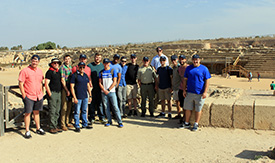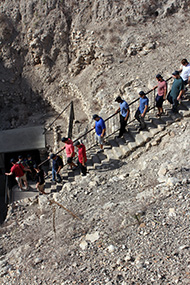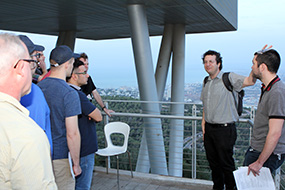HAIFA, Israel – It’s not every day one gets to walk through 15,000 years of history. Fortunately, for the REL 290 students on an immersion trip to Israel, this was the first of what should be many on this visit.
Embarking from Tel Aviv, the group first visited Caesarea Maritima, the Roman Empire outpost, built by King Harod the Great. Roman governors elected to rule from Caesarea’s Palace of Augustus rather than Jerusalem, choosing only to visit the city during festivals to maintain order. In fact, Pontius Pilate resided there when he served as prefect of the Roman province of Judea.
 The stunning display of antiquity featured a huge outdoor theater, hippodrome, seaport, and an aqueduct that once ran roughly eight miles from the water source to Caesarea.
The stunning display of antiquity featured a huge outdoor theater, hippodrome, seaport, and an aqueduct that once ran roughly eight miles from the water source to Caesarea.
“It was a great chance to see ancient architecture, specifically how the Greek and Roman influences impacted the area,” said Taylor King ’18. “It was also stunning to see how the place was torn down and rebuilt, something we also saw at Megiddo as well, that’s one of the themes we’re seeing during our time here. Old meets new. Sacred sites are built on top of one another.
The 19-member group, featuring Professor Robert Royalty and members of his Contested Texts, Contested Sites class, next visited Tel Megiddo, which highlighted both the value of strategic locations and the needs for eternal symbols of hope.
Located in the northern third of Israel, Tel Meggido was on an artery where  control of the city meant control of movement from Egypt to Mesopotamia. Dating back to 15th Century BCE, Meggido was conquered and rebuilt 25 times. Evidence of its existence is literally stacked on top of itself.
control of the city meant control of movement from Egypt to Mesopotamia. Dating back to 15th Century BCE, Meggido was conquered and rebuilt 25 times. Evidence of its existence is literally stacked on top of itself.
“Learning about the cities and why they are important has become so meaningful,” said Luke Gunderman ’18. “We can talk about why it’s been conquered 25 times, but the actual significance to the landscape and why it’s essential, you really can’t get that in a text book. You have to go and see it.”
Simply, Meggido both knew of wars and cultural development, which included a community granary, and an underground water retrieval system that allowed the walled city to access its water supply even when it was under siege.
The day ended with a trip to the University of Haifa and presentations by Tim Alexander, admissions director for the International School, and Dr. Moshe Lavee, who led thought provoking discussions about the Israeli identity.
Alexander, who was born in the U.S., emigrated to Israel in his mid-20’s and spoke openly about his decision and what he experienced in the transition and of his interpretations of modern Israeli society.
Dr. Lavee used the power of music to show the Jewish people’s gradual embrace of a sense of belonging without religious constraints.
“They were able to give a picture of what the culture and the perceptions are like within Israel between the different sects of Jews and Muslims and their interplay,” said Tim Riley ’18. Hearing the perception of those living in the community give you an even deeper understanding of this location place and the effect on those w ho come to visit it.”
ho come to visit it.”
Reno Jamison ’17 said there was a surreal feeling to the start of the nine-day visit. From strolling the streets of Tel Aviv’s Old Jaffa, to hearing the Islamic Call to Prayer for the first time, to taking in the depth of today’s ruins, much of depth of the culture sprang to life today.
“The sites today were thousands of years old,” he said. “You find yourself in Tel Aviv, and then a short bus ride later you are at 8,000-year-old ruins. You can’t get a feeling like that just by studying it all semester. It just comes to life when you are here. It’s such a deeper experience.”